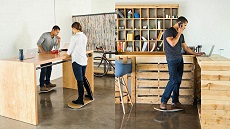
How do you run a successful office environment? Well, as the old saying goes, a happy employee is a productive employee, something that is all too often overlooked by employers trying to get the most bang for their buck. Recently, trends in more forward-looking companies are moving away from long, rigid work days and more towards making employees comfortable so that they can produce the best work possible. One crucial part of this is ensuring that health problems caused by the office workplace are minimized – after all, it doesn’t make sense to have employees off sick because of issues that could have been prevented. Here’s a few things to think about in terms of improving physical workplace well-being.
Ergonomics
Well-designed office furniture and equipment is very important for physical well-being in the office. Back pain is one of the largest contributors to medical leave for employees, so ensuring that chairs are properly designed to prevent the wrong kinds of stresses being placed on the spine is essential. Many ergonomic office chairs don’t have backs, which stops people from leaning on them and getting into bad posture habits. Often, such chairs have higher seats than normal, to put their users in a half-standing posture, reducing the curvature of the spine. Alternatively, some designs allow the shins to rest on specially built pads, providing extra support. Having a reliable podiatrist Toowoomba in your office can help with the employee’s postures.
Another huge contributor to workplace discomfort and employee time off is repetitive strain injury when typing with a suboptimal hand position. Because office work is almost exclusively keyboard-based these days, it is easy to overexert oneself when using a computer all day. However, traditional horizontal keyboard layouts don’t account for natural hand posture. If you hold your hands in front of you close together, as is required when using a keyboard, you can see that they naturally form around a 30° angle to the depth axis (i.e., towards the back of the keyboard). If you push them to align with this axis, you will put outward pressure on your wrists, which can cause complications such as carpal tunnel syndrome if the problem is not corrected. Ergonomic keyboards solve this problem by incorporating the angle directly into the keyboard’s design, so that the wrists are not stressed while typing.
Standing and Active Sitting
Sitting for prolonged periods, even with an ergonomic chair, is not considered best practice for avoiding back problems in the long term. This can be somewhat ameliorated by active sitting (also known as dynamic sitting), where seating allows or encourages the seated occupant to move. The idea is that this flexibility and movement is beneficial to the body and can make some seated tasks easier to perform. Many office furniture products now allow different kinds of movement: forward and backward, side to side, etc. Like postures that are encouraged by ergonomic office chairs, active sitting activates and strengthens muscles in the back and core area to relieve the loads acting on joints, ligaments and tendons, leading to improved posture and core stability.
The development of the standing desk is an extremely important change in physical office culture over the last decade or so. Such desks completely remove the pressure on the spine from sitting, and encourage better posture overall. Moreover, stand-up meetings have also started to become a thing in the office. They tend to be shorter, because standing up is more tiring, so meetings are kept more concise and to the point. They also feel more natural, more like meeting people we know at the bar or by the water cooler to chat for a few minutes, and being this way in officially scheduled meetings often promotes discussion in a similar way.
If your office doesn’t yet have access to ergonomic furniture or standing desks, there are a few things you can do to ameliorate the effects of prolonged sitting on suboptimal furniture. Just standing up for a few minutes every hour will help, and doing a few exercises or stretches during this break is even better. You might want to use a computer program or phone app to remind you when to do it. A wearable fitness tracker is also a good idea; it will let you know when you haven’t moved for a while. You could also keep some smaller gadgets on hand, like a tennis ball to roll around on your back on your chair and ease the tension in your back muscles. And don’t forget that fidgeting and wiggling around can also help relieve the pressure. It all adds up!
Related posts:






